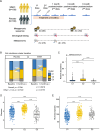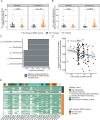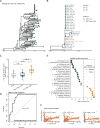The resident gut microbiome modulates the effect of synbiotics on the immunogenicity after SARS-COV-2 vaccination in elderly and diabetes patients
- PMID: 40851072
- PMCID: PMC12375777
- DOI: 10.1038/s41522-025-00804-9
The resident gut microbiome modulates the effect of synbiotics on the immunogenicity after SARS-COV-2 vaccination in elderly and diabetes patients
Abstract
The study aims to tackle the seed and soil microbiome and mechanisms that contribute to the effect of synbiotics in enhancing immunogenicity after SARS-CoV-2 vaccination in elderly and diabetic patients. Among 369 subjects who received 3 months of SIM01, a gut microbiota-derived synbiotic formula of three Bifidobacterium strains (B. adolescentis, B. bididum, and B. longum) or a placebo after the SARS-CoV-2 vaccines (mRNA vaccine BNT162b2 (Pfizer-BioNTech) or the inactivated vaccine Sinovac-CoronaVac), we performed metagenomic sequencing in stool samples of 280 vaccinees collected at baseline and 3-month postvaccination and metabonomic sequencing in 276 vaccinees collected at baseline and 1-month postvaccination. The open niche of autochthonous gut microbiota (lower levels of Bifidobacterium and decreased functional potential for carbohydrate metabolism) was associated with enhancing SIM01-contained species. The enrichment of three bifidobacterial species after 3 months of SIM01 intervention (BABBBL_fc) was positively correlated with the level of neutralizing antibodies to the BNT162b2 vaccine at 6-month postvaccination. The fold change of benzoic acid was positively correlated with BABBBL_fc in the BNT162b2 vaccinees, which was also implicated with SARS-CoV-2 surrogate virus neutralization test (sVNT)% levels at 1-month postvaccination. Importantly, SIM01 strain engraftment assessed by StrainPhlAn (A metagenomic strain-level population genomics tool) was associated with a higher fold change of three bifidobacterial species and could be predicted based on the baseline gut microbiome. Therefore, the resident gut microbiome affected the SIM01 engraftment, which was associated with the immunogenicity of SARS-CoV-2 BNT162b2 vaccines.
© 2025. The Author(s).
Conflict of interest statement
Competing interests: F.K.L.C serves as the Principal Investigator for the Faecal Microbiota Transplantation Service under the Hospital Authority (HA). He is a Board Director of EHealth Plus Digital Technology Ltd., an HA-owned subsidiary driving the eHealth+ programme to transform the Electronic Health Record Sharing System into a comprehensive digital healthcare platform and advance other IT initiatives within the eHealth ecosystem. Additionally, he is a Board Director of CUHK Medical Services Limited. F.K.L.C is a shareholder of GenieBiome Holdings Limited and the co-founder, non-executive Board Chairman, and non-executive Scientific Advisor of its wholly owned subsidiary, GenieBiome Ltd. Similarly, he is a shareholder of MicroSigX Diagnostic Holding Limited and the co-founder, non-executive Board Chairman, and non-executive Scientific Advisor of its wholly owned subsidiary, MicroSigX Biotech Diagnostic Limited. He also serves as a Director of the Hong Kong Investment Corporation Limited and a member of the Steering Committee for the RAISe+ Scheme under the Innovation and Technology Commission. Furthermore, he is the Co-Director of the Microbiota I-Center (MagIC) Ltd. F.K.L.C receives advisory fees and speaker honoraria from AstraZeneca and Comvita New Zealand Limited, as well as patent royalties through affiliated institutions for microbiome-related applications. S.C.N. has served as an advisory board member for Pfizer, Ferring, Janssen, and Abbvie and received honoraria as a speaker for Ferring, Tillotts, Menarini, Janssen, Abbvie, and Takeda. She has received research grants through her affiliated institutions from Olympus, Ferring, and AbbVie, and is a founder member of GenieBiome Ltd, is a shareholder of GenieBiome Holdings Limited; GenieBiome Limited is wholly owned by GenieBiome Holdings Limited; is a non-executive Board director and non-executive scientific advisor of GenieBiome Ltd and its holding company which is non-remunerative; is a founder member of MicroSigX Biotech Diagnostic Limited; is a shareholder of MicroSigX Diagnostic Holdings Limited; GenieBiome Limited is wholly owned by GenieBiome Holdings Limited; is a non-executive Board director and non-executive scientific advisor of MicroSigX Biotech Diagnostic Limited and its holding company which is non-remunerative; and receives patent royalties through her affiliated institutions. F.K.L.C., S.C.N., and L.Z. are named inventors of patent applications held by the CUHK and MagIC that cover the therapeutic and diagnostic use of the microbiome. The remaining authors declare no competing interests.
Figures




Similar articles
-
BNT162b2 versus mRNA-1273 Third Dose COVID-19 Vaccine in Patients with CKD and Maintenance Dialysis Patients.Clin J Am Soc Nephrol. 2024 Jan 1;19(1):85-97. doi: 10.2215/CJN.0000000000000328. Epub 2023 Oct 17. Clin J Am Soc Nephrol. 2024. PMID: 37847518 Free PMC article. Clinical Trial.
-
The impact of vaccine booster doses on specific B- and T-lymphocyte dynamics in Thai healthcare personnel following COVID-19 vaccination.Sci Rep. 2025 Jul 16;15(1):25713. doi: 10.1038/s41598-025-10400-8. Sci Rep. 2025. PMID: 40670524 Free PMC article.
-
Safety and immunogenicity of a modified mRNA-lipid nanoparticle vaccine candidate against COVID-19: Results from a phase 1, dose-escalation study.Hum Vaccin Immunother. 2024 Dec 31;20(1):2408863. doi: 10.1080/21645515.2024.2408863. Epub 2024 Oct 18. Hum Vaccin Immunother. 2024. PMID: 39422261 Free PMC article. Clinical Trial.
-
Efficacy and safety of COVID-19 vaccines.Cochrane Database Syst Rev. 2022 Dec 7;12(12):CD015477. doi: 10.1002/14651858.CD015477. Cochrane Database Syst Rev. 2022. PMID: 36473651 Free PMC article.
-
COVID-19 Vaccines.2025 Aug 15. Drugs and Lactation Database (LactMed®) [Internet]. Bethesda (MD): National Institute of Child Health and Human Development; 2006–. 2025 Aug 15. Drugs and Lactation Database (LactMed®) [Internet]. Bethesda (MD): National Institute of Child Health and Human Development; 2006–. PMID: 33355732 Free Books & Documents. Review.
References
MeSH terms
Substances
Grants and funding
- COVID19F07/Health Bureau, The Government of the Hong Kong Special Administrative Region
- COVID19F07/Health Bureau, The Government of the Hong Kong Special Administrative Region
- COVID19F07/Health Bureau, The Government of the Hong Kong Special Administrative Region
- COVID19F07/Health Bureau, The Government of the Hong Kong Special Administrative Region
- NCI202346/New Cornerstone Science Foundation
LinkOut - more resources
Full Text Sources
Medical
Miscellaneous

